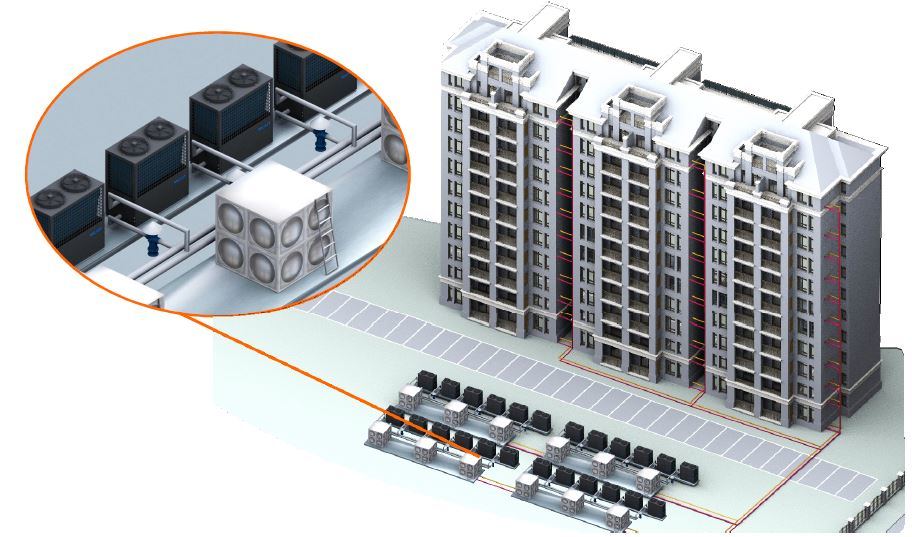The Future of Heating and Cooling: Large-Scale Heat Pumps for Cities.
As the world continues to battle the effects of climate change, more and more cities are looking for sustainable and cost-effective solutions to heating and cooling buildings. One of the most innovative and effective solutions to emerge in recent years is the use of enormous heat pumps to warm entire cities.
In this article, we will explore the concept of enormous heat pumps and their role in warming cities. We will examine how they work, and what benefits they offer, and highlight some real-life examples and case studies of successful implementations of this technology.
What are Enormous Heat Pumps?
Enormous heat pumps are a type of renewable energy technology that uses the natural heat in the air, water, and ground to warm buildings and other structures. Unlike traditional heating methods that rely on burning fossil fuels, heat pumps do not produce greenhouse gas emissions, making them an environmentally friendly solution.
Enormous heat pumps are called such because they are much larger than traditional heat pumps. While traditional heat pumps are used to heat individual homes, enormous heat pumps are used to heat entire cities.
How do Enormous Heat Pumps Work?
Enormous heat pumps work by transferring heat from a heat source, such as the air, water, or ground, to a heat sink, such as a building or other structure. The heat transfer process is achieved through the use of a refrigerant, which absorbs heat from the heat source and then releases it into the heat sink.
There are two primary types of enormous heat pumps: air-source and ground-source. Air-source heat pumps extract heat from the outside air, while ground-source heat pumps extract heat from the ground.
Air-source heat pumps work by using a refrigerant to extract heat from the outside air. The refrigerant is then compressed, which raises its temperature, and then circulated through a heat exchanger, where it transfers the heat to the building or other structure. The refrigerant is then allowed to expand, which lowers its temperature, and is circulated back to the outdoor unit, where the process starts over.
Ground-source heat pumps work in a similar way, but instead of extracting heat from the outside air, they extract heat from the ground. This is achieved by burying a series of pipes underground, where they can extract heat from the soil or groundwater. The heat is then transferred to a heat exchanger and circulated through the building or other structure.
What are the Benefits of Enormous Heat Pumps?
Enormous heat pumps offer a range of benefits compared to traditional heating methods. Some of the most significant benefits include:
- Lower Cost: Enormous heat pumps can be much more cost effective than traditional heating methods, especially in larger buildings and structures.
- Environmentally Friendly: Enormous heat pumps produce no greenhouse gas emissions and are therefore an environmentally friendly solution.
- Energy-Efficient: Enormous heat pumps are much more energy-efficient than traditional heating methods, which means they can help reduce overall energy consumption and costs.
- Consistent Temperature: Enormous heat pumps can provide a more consistent temperature throughout a building, which can help improve comfort levels and reduce energy costs.
- Low Maintenance: Enormous heat pumps require very little maintenance, which can help reduce overall operating costs.
Heat Pumps in Urban Settings
One of the main advantages of heat pumps is that they can be used in both urban and rural environments. However, their implementation in urban areas poses some unique challenges.
The biggest challenge is finding suitable locations for the outdoor units, which require space and access to fresh air. However, with careful planning and creative design, it is possible to integrate heat pumps into urban environments.
One approach is to install heat pumps on rooftops or in courtyards, where they are out of sight and can be easily accessed for maintenance. Another option is to use vertical heat pumps, which are specifically designed for urban environments and take up less space than traditional heat pumps.
Examples and Case Studies of Enormous Heat Pumps in Action
here are a few examples of large-scale heat pump projects that have been implemented in recent years:
1. Enwave’s Deep Lake Water Cooling System
Enwave’s Deep Lake Water Cooling System in Toronto, Canada is a prime example of a large-scale heat pump project. This system uses water from Lake Ontario to provide cooling to buildings in the downtown core. During the summer, water from the bottom of the lake, which remains at a constant 4°C, is pumped to a heat exchanger in the Enwave central plant, where it is used to cool the water that is distributed to buildings in the area. In the winter, the system can be reversed, and heat can be extracted from the water to provide warmth to the buildings. This system provides a sustainable and cost-effective alternative to traditional cooling and heating systems and has helped to reduce greenhouse gas emissions in the area.
2. Fortum’s Heat Pump in Helsinki, Finland
Fortum’s heat pump in Helsinki, Finland is one of the largest heat pumps in the world, with the capacity to warm 10,000 homes in the city. This system utilizes heat from the wastewater of the city to provide heat to homes and buildings. The heat pump extracts heat from the wastewater, and then the clean water is returned back to the environment. This system has helped to decrease greenhouse gas emissions and provide a renewable and sustainable source of heat for the city.
3. EcoBerg’s Ice Thermal Energy Storage in Copenhagen, Denmark
EcoBerg’s Ice Thermal Energy Storage in Copenhagen, Denmark is another example of a large-scale heat pump project. This system uses ice thermal energy storage to provide cooling to buildings in the city. During the night, electricity is used to freeze water, which is then stored in tanks. During the day, the tanks are used to provide cooling to buildings in the area. This system has helped to reduce the energy costs for cooling in the city and provides a sustainable and cost-effective alternative to traditional cooling systems.
These examples demonstrate the potential for large-scale heat pumps to provide sustainable and cost-effective heating and cooling solutions for cities and buildings.
Frequently Asked Question
Q: How efficient are enormous heat pumps compared to traditional heating and cooling systems?
A: Enormous heat pumps can be much more efficient than traditional heating and cooling systems, particularly when they are used to extract heat from waste sources such as lake water or wastewater. In some cases, these systems can achieve efficiencies of over 400%, meaning that they can provide four units of heating or cooling for every unit of energy input. This high level of efficiency can result in significant energy cost savings and lower greenhouse gas emissions.
Q: Are enormous heat pumps expensive to install?
A: The cost of installing an enormous heat pump system can vary widely depending on the size of the system, the complexity of the installation, and the specific source of heat or cooling that is being used. However, in many cases, these systems can provide significant cost savings over the long term, particularly in situations where waste heat sources are being utilized. Additionally, there are often government incentives and financing options available to help offset the initial installation costs of these systems.
Q: How long do enormous heat pump systems typically last?
A: Enormous heat pump systems can last for many years, with lifetimes of 20 years or more being common. The lifespan of the system will depend on a variety of factors, including the quality of the equipment, the maintenance and upkeep of the system, and the conditions under which it is operated. Regular maintenance and servicing can help to extend the life of the system and ensure that it operates at peak efficiency.
Q: Can enormous heat pumps be used in both residential and commercial settings?
A: Yes, enormous heat pumps can be used in both residential and commercial settings. While these systems are often used to provide heating and cooling to large buildings or entire city districts, they can also be used to provide efficient and sustainable heating and cooling to individual homes or smaller commercial buildings. The key is to size the system appropriately for the specific application and to utilize the most appropriate heat or cooling source available.
Q: Are enormous heat pumps a truly sustainable solution for heating and cooling?
A: Enormous heat pumps are considered to be a highly sustainable solution for heating and cooling, particularly when they are used to extract heat from waste sources such as wastewater or lake water. By utilizing waste heat that would otherwise be lost, these systems can significantly reduce greenhouse gas emissions and provide a renewable and sustainable source of heating and cooling for urban areas. However, as with any technology, the sustainability of enormous heat pumps will depend on the specific application, the source of heat or cooling being utilized, and the efficiency of the system.
Conclusion
Enormous heat pumps are emerging as a key technology for sustainable and efficient heating and cooling in urban areas. These heat pumps are being used to extract heat from various sources, such as wastewater, lake water, and even air, and to provide heating and cooling to buildings and entire city districts. Large-scale heat pump projects have already been implemented in many parts of the world, and have demonstrated their potential to significantly reduce greenhouse gas emissions, lower energy costs, and provide renewable and sustainable sources of heat for cities.
As the world continues to shift towards renewable energy and sustainable solutions, the use of enormous heat pumps is likely to become more widespread. With their ability to utilize waste heat and other sources, these systems are an attractive option for building owners and city planners looking for cost-effective and sustainable ways to provide heating and cooling to urban areas. As we continue to tackle the challenges of climate change and the need for sustainable solutions, enormous heat pumps are sure to play an important role in building a greener and more sustainable future.

